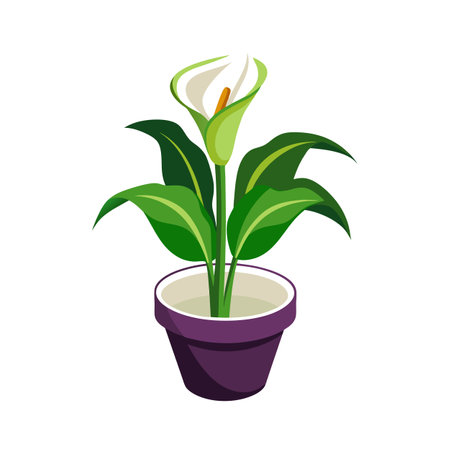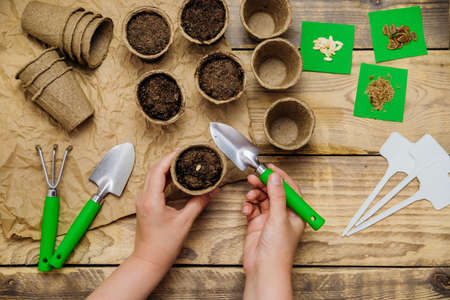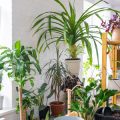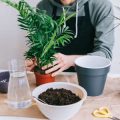1. Why Light Matters for Indoor Plants
Light is one of the most important factors in keeping your indoor plants healthy and happy. Just like people need food to survive, plants need light to perform a process called photosynthesis. This is how they convert light energy into the sugars they use to grow, produce leaves, and stay strong.
Without enough light, your houseplants may become leggy, lose their color, or stop growing altogether. On the other hand, too much direct sunlight can scorch their leaves. Understanding how light affects your indoor plants will help you choose the right spot for each plant in your home.
How Photosynthesis Works
Photosynthesis is how plants turn light into energy. When light hits a plant’s leaves, it triggers a chemical reaction that transforms carbon dioxide from the air and water from the soil into glucose (a type of sugar) and oxygen. The plant uses this glucose to grow and thrive.
Basic Equation of Photosynthesis:
Carbon Dioxide + Water + Light Energy → Glucose + Oxygen
Different Light Levels Explained
Not all indoor spaces have the same amount of light. Knowing what kind of light each room in your home gets can help you match the right plant to the right location.
| Light Level | Description | Best Plant Types |
|---|---|---|
| Bright Indirect Light | Near windows with filtered sunlight or behind sheer curtains | Fiddle Leaf Fig, Monstera, Peace Lily |
| Medium Light | A few feet away from windows; receives indirect light for part of the day | Pothos, Spider Plant, Dracaena |
| Low Light | Shaded corners or rooms with little natural light | Snake Plant, ZZ Plant, Cast Iron Plant |
The Impact of Improper Lighting
If a plant doesn’t get enough of the right kind of light, you’ll notice signs like slow growth, smaller leaves, pale colors, or leaning toward a window. These are signs that your plant is struggling to get enough energy from photosynthesis.
Common Symptoms of Light Issues:
- Too Little Light: Yellowing leaves, weak stems, leaf drop
- Too Much Light: Brown spots on leaves, dry edges, faded color
By observing these signs and understanding how light works for plants, you can make better choices about where to place your indoor greenery and how to care for them properly.
2. Types of Light: Direct, Indirect, and Low Light
When it comes to keeping your indoor plants happy and healthy, understanding the kind of light they need is key. Not all light is created equal, and different types of light can make a big difference in how well your plants grow. Let’s break down the three main types of indoor light—direct, indirect, and low light—and how to recognize them in your home.
Direct Light
Direct light refers to sunlight that shines straight onto your plant without any obstruction. This usually happens near south-facing windows (in the U.S.), where the sun beams directly through the glass for most of the day. Plants like succulents, cacti, and some herbs love this type of intense light.
How to Identify:
- Your plant casts a sharp, well-defined shadow.
- The area feels warm during the day from sun exposure.
- You can see the sun hitting the spot for at least 6 hours a day.
Indirect Light
Indirect light means sunlight reaches the plant but is filtered or bounced off another surface first. This is common in rooms with bright ambient light or when plants are set back a few feet from a sunny window. Many popular houseplants like pothos, peace lilies, and spider plants thrive in indirect light.
How to Identify:
- Your plant casts a soft or blurry shadow.
- The area is bright but not exposed to direct sun rays.
- This kind of light is often found near east- or west-facing windows with sheer curtains or in bright rooms away from direct sunspots.
Low Light
Low light areas are spaces where little natural light reaches. These spots might be several feet away from any window or even in rooms with only artificial lighting. While it may seem too dim for plants, there are still varieties that can adapt well, such as snake plants, ZZ plants, and philodendrons.
How to Identify:
- Your plant casts little to no shadow.
- The space relies on lamps or gets minimal natural daylight.
- This condition is common in bathrooms, offices, or north-facing rooms.
Quick Light Type Comparison
| Light Type | Description | Ideal Location | Good Plant Choices |
|---|---|---|---|
| Direct Light | Sunlight hits the plant directly for several hours | South-facing window | Cactus, Succulents, Basil |
| Indirect Light | Bright but filtered or reflected light | East/West window with curtain or interior spot near window | Pothos, Peace Lily, Spider Plant |
| Low Light | Little natural light; mostly artificial sources | North-facing room or far from windows | Sanke Plant, ZZ Plant, Philodendron |
Learning to recognize these types of light in your home helps you choose plants that are more likely to thrive where you place them. Take a few days to observe how sunlight moves through your space—this small step can make a big difference in your indoor gardening success!

3. Finding the Right Light for Common Houseplants
Different houseplants have different light needs, and understanding these requirements can help your indoor garden thrive. Whether youre dealing with a sunny windowsill or a dim corner, theres a plant that will fit just right. Here’s how to match popular indoor plants with the right kind of light.
Understanding Light Levels
Before diving into specific plants, its helpful to know the basic categories of indoor light:
- Bright, indirect light: A well-lit room without direct sun rays hitting the plant. Often found near east or north-facing windows.
- Direct sunlight: Sunlight that comes straight through the window and lands on the plant. South or west-facing windows usually provide this.
- Low light: Areas far from windows or rooms with minimal natural light.
Light Requirements for Popular Indoor Plants
Heres a quick guide to the preferred lighting conditions for some of the most common houseplants:
| Plant | Light Requirement | Best Placement |
|---|---|---|
| Succulents (e.g., Echeveria, Aloe) | Bright, direct sunlight | South or west-facing windowsills |
| Pothos (Epipremnum aureum) | Low to medium, indirect light | A few feet away from any window; great for offices and bathrooms |
| Fiddle Leaf Fig (Ficus lyrata) | Bright, indirect light | Near a large east-facing window with filtered light |
| Peace Lily (Spathiphyllum) | Low to medium, indirect light | In corners of bright rooms or near shaded windows |
Tips for Positioning Your Plants at Home
#1. Rotate Regularly
Plants tend to grow toward their light source. Rotate them every week or two so they grow evenly on all sides.
#2. Watch for Signs of Too Much or Too Little Light
If leaves are scorched or faded, your plant might be getting too much sun. If it’s leggy or has slow growth, it may need more light.
#3. Adjust with the Seasons
The amount of natural sunlight changes throughout the year. You may need to move your plants closer to windows during winter months when daylight is weaker.
#4. Supplement with Grow Lights When Needed
If you don’t have enough natural light in your home, especially during winter, consider using LED grow lights to keep your plants happy and healthy.
Matching your houseplants with the right type of lighting doesn’t have to be complicated. With a little observation and the right placement, you’ll create an environment where both you and your green friends can thrive.
4. Using Natural and Artificial Light
When growing indoor plants, understanding how to use both natural sunlight and artificial grow lights can make a big difference in your plants health. Not all homes have ideal lighting conditions, so knowing when and how to supplement with artificial light is key.
Comparing Sunlight and Grow Lights
Natural sunlight is the best source of light for most plants because it provides the full spectrum of light they need for photosynthesis. However, not all homes receive enough sunlight throughout the day—especially during winter or in north-facing rooms.
| Light Source | Pros | Cons |
|---|---|---|
| Sunlight | Free, full spectrum, supports healthy growth | Limited by season, window direction, and weather |
| Grow Lights | Customizable, consistent, works anywhere in your home | Requires electricity, upfront cost for bulbs and fixtures |
When to Supplement with Artificial Lighting
If your indoor plants show signs of struggling—like leggy growth, pale leaves, or no new growth—they may not be getting enough light. This is especially common in low-light apartments or during shorter winter days. In these cases, adding a grow light can help provide the necessary boost.
Signs Your Plant Needs More Light:
- Stretched or elongated stems (known as “leggy” growth)
- Pale or yellowing leaves
- No new leaf development over time
- Slower overall growth despite regular care
Choosing the Right Placement and Bulbs
The placement of your plant and grow light matters. Position your grow light 6–12 inches above the plant for best results, depending on the type of bulb and how much light your plant needs. Also consider how long to leave the lights on—most houseplants do well with 12–16 hours of light per day.
Common Types of Grow Light Bulbs:
| Type of Bulb | Description | Best For |
|---|---|---|
| Fluorescent (CFL or T5) | Energy-efficient and affordable; cool to the touch | Low- to medium-light plants like pothos or ferns |
| LED Grow Lights | Long-lasting and customizable spectrum options | All types of plants; great for small spaces or shelves |
| Incandescent Bulbs (Not recommended) | Tend to produce too much heat and limited spectrum range | Avoid using for most indoor plants due to inefficiency and heat risk |
Selecting the right balance between natural and artificial light will help ensure your indoor plants stay vibrant and healthy year-round.
5. How to Monitor and Adjust Your Plant’s Lighting Needs
Understanding how much light your indoor plants are actually getting is just as important as knowing what they need. Not all spots in your home offer the same amount of light, and even small changes—like a seasonal shift or moving furniture—can impact your plants health.
Easy Ways to Check Light Levels
You don’t need fancy tools to figure out the light situation in your home. Here are a few simple methods:
1. The Shadow Test
Stand where your plant sits during the brightest part of the day and hold your hand about a foot above a white surface (like a sheet of paper or wall). Look at the shadow:
| Shadow Type | Light Level |
|---|---|
| Sharp and dark shadow | Bright, direct light |
| Soft, blurry shadow | Bright, indirect light |
| Very faint or no shadow | Low light |
2. Use a Light Meter App
Several free smartphone apps can measure light in lux or foot-candles. While not as precise as professional meters, they’re helpful for giving you a general idea of whether your plant’s spot is too dark or too bright.
Signs Your Plant Needs More or Less Light
Your plant will show you if its unhappy with its lighting. Keep an eye out for these signs:
| Plant Behavior | Possible Cause |
|---|---|
| Leaves fading or losing color | Too much direct sunlight or not enough light overall |
| Leggy growth (stretching toward light) | Not enough light; plant reaching for more |
| Leaf drop or slow growth | Inadequate light or sudden change in environment |
| Crispy leaf edges or scorched spots | Too much direct sun exposure |
Adjusting Light for Healthier Plants
Move Your Plant Closer to a Window
If your plant isn’t getting enough light, try placing it nearer to a south- or west-facing window, which typically gets the most sunlight during the day in the U.S.
Add Supplemental Lighting
If natural light is limited—especially during winter—consider using grow lights. LED grow lights are energy-efficient and can be tailored to your plants needs.
Filter Harsh Sunlight
If your plant is getting too much direct sun, use sheer curtains to soften the intensity. Many tropical plants prefer bright but indirect light.
Tip:
If youre rotating your plants every few weeks, it helps ensure even growth and prevents them from leaning too heavily toward one direction.
The key is observation. Regularly check on your plants and take note of any changes in their appearance. It’s the best way to catch lighting issues early and keep your indoor garden thriving.


